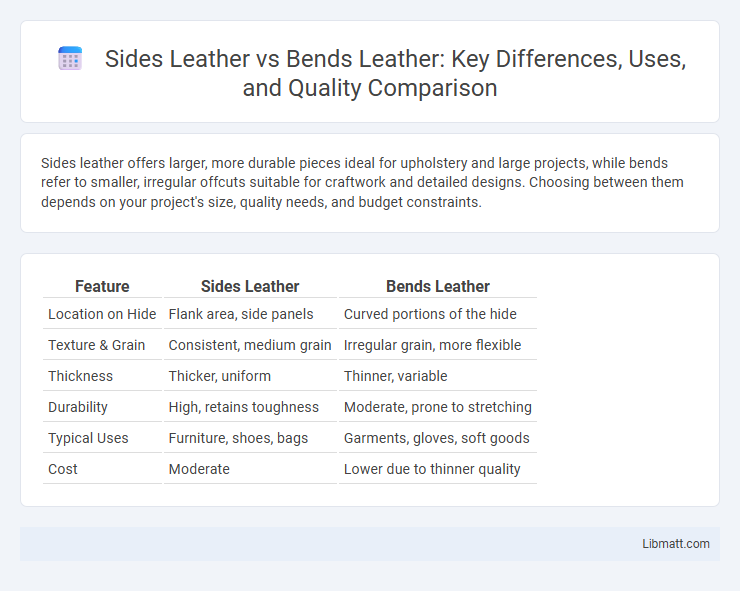Sides leather offers larger, more durable pieces ideal for upholstery and large projects, while bends refer to smaller, irregular offcuts suitable for craftwork and detailed designs. Choosing between them depends on your project's size, quality needs, and budget constraints.
Table of Comparison
| Feature | Sides Leather | Bends Leather |
|---|---|---|
| Location on Hide | Flank area, side panels | Curved portions of the hide |
| Texture & Grain | Consistent, medium grain | Irregular grain, more flexible |
| Thickness | Thicker, uniform | Thinner, variable |
| Durability | High, retains toughness | Moderate, prone to stretching |
| Typical Uses | Furniture, shoes, bags | Garments, gloves, soft goods |
| Cost | Moderate | Lower due to thinner quality |
Introduction to Sides Leather and Bends
Sides leather refers to large, split sections of hides typically measuring half the size of a full hide, prized for their uniform thickness and durability in upholstery and garment manufacturing. Bends are narrower strips cut longitudinally from the sides of a hide, often used for smaller leather goods like wallets and belts due to their consistent grain and strength. Both sides leather and bends offer versatile options, with sides preferred for larger projects and bends ideal for precision crafting.
Defining Sides Leather: Characteristics and Uses
Sides leather refers to the large, primary sections of a hide split lengthwise, known for their uniform thickness and versatility in craftsmanship. Its consistent texture and durability make it ideal for producing high-quality furniture, automotive upholstery, and premium leather goods. Understanding the unique characteristics of sides leather helps you select the best material for projects requiring both strength and aesthetic appeal.
What Are Bends? Overview and Applications
Bends refer to medium-sized sections of leather taken from the sides of animal hides, offering a balance between size and flexibility. These pieces provide a versatile option for crafting items like wallets, bags, and furniture upholstery, where both durability and aesthetic appeal are crucial. Choosing bends can optimize your projects by delivering consistent quality without the bulk of full hides or the limitations of smaller cuts.
Key Differences Between Sides Leather and Bends
Sides leather comes from the sides of an animal's hide, offering larger, more consistent pieces ideal for upholstery and fashion. Bends leather refers to the back portion of the hide, which is thicker but less uniform, often used in durable goods like saddles and heavy-duty gear. Understanding these key differences helps you select the right leather type for your specific project based on thickness, texture, and durability requirements.
Durability Comparison: Sides vs Bends
Sides leather typically offers greater durability compared to bends due to its thicker, more uniform grain structure, which withstands wear and tear better over time. Bends, derived from the middle part of the hide, are thinner and more flexible but may show signs of stretching and wear sooner in high-stress applications. Choosing sides leather ensures enhanced longevity for products subjected to frequent use and abrasion.
Cost Analysis: Which Is More Economical?
Sides leather generally offers a more economical option compared to bends leather due to its larger, less processed sections, reducing manufacturing waste and labor costs. Bends leather, cut from a specific curved part of the hide, is priced higher because of its superior quality and consistent texture, which demands precision and increases production expenses. Your choice depends on balancing budget constraints with desired quality, where sides leather suits cost-effective projects, while bends leather fits premium applications.
Cutting Yield and Waste: Sides Leather vs Bends
Sides leather offers a larger continuous surface area, resulting in higher cutting yields and less waste compared to bends. Bends are smaller, more irregular sections that limit pattern placement and increase material waste during cutting. Optimizing your leather choice based on sides or bends can significantly impact material efficiency and cost-effectiveness.
Best Projects for Sides Leather
Sides leather, typically thinner and more flexible than bends, is ideal for crafting items requiring moderate durability and pliability, such as wallets, gloves, and small bags. This type of leather offers a balance of strength and softness, making it perfect for projects that benefit from both comfort and resilience. Your best projects with sides leather involve accessories and apparel components where flexibility enhances functionality without compromising quality.
Ideal Uses for Bends in Leathercraft
Bends in leathercraft are ideal for projects requiring medium thickness and flexibility, such as wallets, belts, and small bags. They offer a balance between durability and pliability, making them suitable for items that need to withstand moderate wear while maintaining shape. Your choice of bends leather ensures versatility and cost-effectiveness without compromising quality.
How to Choose Between Sides Leather and Bends
Choosing between sides leather and bends depends on your project's requirements for quality and budget; sides leather offers larger, more uniform sections ideal for premium goods, while bends provide smaller, irregular pieces suitable for economical or smaller-scale products. Consider the end use, as sides leather is better for items requiring consistent thickness and durability, whereas bends can be more cost-effective for patchwork or tested usage. Your decision should balance the desired finish, strength, and cost constraints to ensure optimal material performance.
Sides leather vs bends Infographic

 libmatt.com
libmatt.com